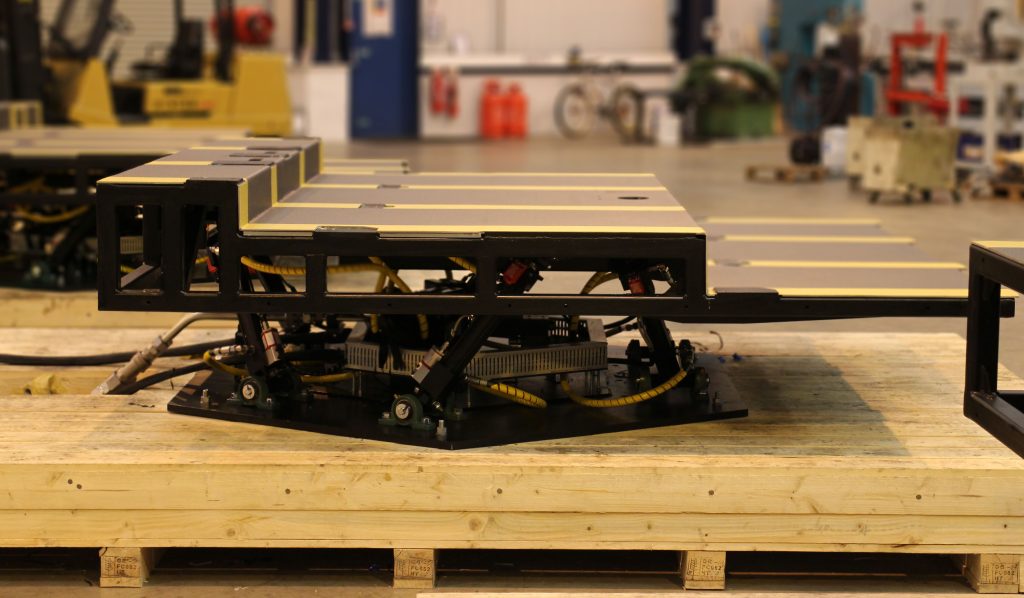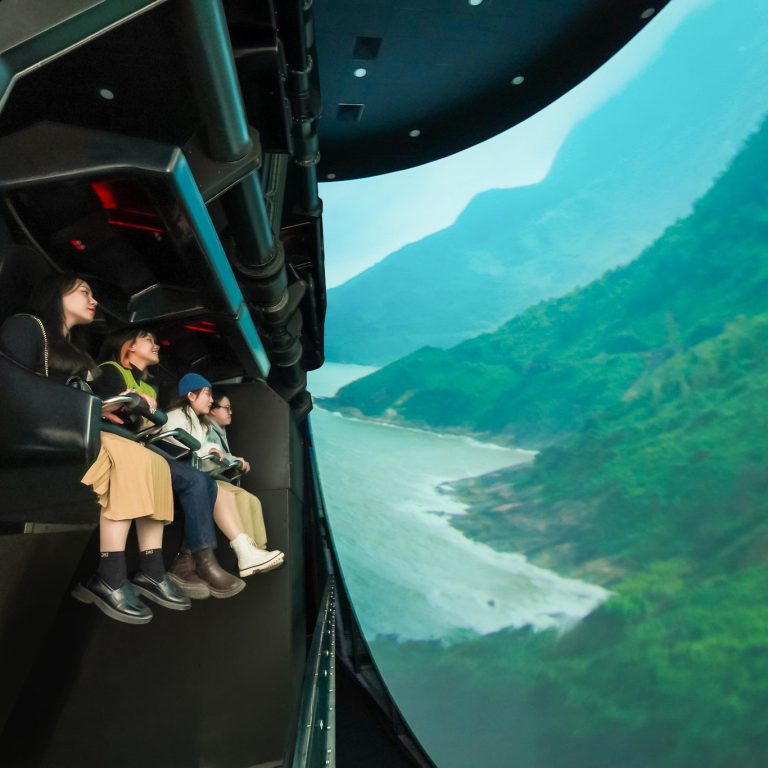At the core of our expertise lies the seamless integration of two fundamental elements: Media and Movement. This fusion gives birth to what we proudly term Media-Based Attractions, where the convergence of cutting-edge simulator ride systems and immersive media results in an unparalleled escape. This article delves into the intricacies of harmonising these two elements, shedding light on the considerations that underpin their successful amalgamation.
Making Motion
The cornerstone of our rides is our state-of-the-art motion base technology, manifesting in various forms such as 2,3 or 6 Degrees-of-Freedom (DOF). DOF denotes the rotational axes that a rigid body can freely move in three-dimensional space encompassing Pitch, Yaw, Roll, Heave, Surge, and Sway. These are the directions that our motion-bases can be programmed to move and rotate to create the ride motion. Each ride is manually programmed by our team who repeatedly study the ride media, working out how the ride vehicles should move in correlation to the on-screen action. Whether this be being thrust forward as the story has riders flying off a cliff or dodging obstacles as they navigate a fantastic landscape. By combining and modulating these movements in intensity and duration, we synchronise them perfectly to deliver riders with authentic immersion into an imagined world.

Ride Media – Library VS Custom
The complementary half of our Media-Based Attractions is, unsurprisingly, the media itself. Collaboration with various media production houses is a crucial aspect of our projects, driven either by our recommendation or client preference. During the project’s creative inception, collaboration with clients helps refine media aspirations, considering factors like screen format, thematic alignment, and movie duration. While library media offers advantages in terms of lead time and cost, custom media becomes imperative when existing content fails to align with the chosen audio-visual solution.
The choice between library and custom content often dictates our media production partners. In cases where the narrative is undecided, we aid clients in crafting a cohesive narrative that complements the pre-show and ride experience, utilising storyboards to guide their media partner selection process.
Pipeline from Animation to Install
Before installation, upon receiving a rough animatic of the media in the case of a custom film, our proprietary specialist programs come into play. These programs enable us to program each axis while visualizing real-time motion base tilts, synchronized with the rough animation. This process results in a working draft of the integrated movement and media. On-site, our team rigorously tests the attractions, riding alongside clients to fine-tune the experience to meet their expectations of thrill and intensity. Once they’ve got it just right, and have made any tweaks necessary, they’ll finalise the motion profile. Post-opening, if any adjustments are required, remote adjustments can be made to ensure a dynamic response to client preferences.
See below how we used the previsualised version of the media for the Immersive Tunnel Ride at Hub Zero, as a reference prior to installation in order to program the motion-base virtually.
When we worked with Dreamworks on our Kung Fu Panda: Unstoppable Awesomeness attraction for Motiongate Dubai, we even provided our software early for their animation production pipeline. This gave animators a better understanding of the kind of movements that were possible from the motion base to help them comprehend the boundaries of the movement they could mimic on-screen.


Importance of Synched Media
The synchronization of motion bases with media is paramount not only for an authentic experience but also for mitigating motion-sickness side effects. People tend to feel dizzy or nauseated when their brains receive conflicting messages from the motion-sensing organs in their bodies, such as the inner ears and eyes, so any mismatch in movement and media can greatly influence somebody’s potential to feel nauseous whilst onboard a motion ride. Precision in synchronization serves both authenticity and rider comfort, aligning the immersive experience with our quality standards.
Specialist Media Formats
Many of our rides employ specialized screen formats chosen for ride type or space constraints while maintaining the most immersive experience possible. But with this comes the complexities of mapping the media to a custom surface. Balancing images from multiple projectors onto custom surfaces involves strategic projector placement to create seamless edges through 10-15% overlap. The bigger the screen, the more projectors required and the more complex the mapping. Not only are we mapping the flat images but we also in some cases have to take into consideration requirements for 3D, with the audience’s position being an important factor to ensure the 3D effect works.
When we have particularly large, stretched, or wide screens then we also need custom-formatted media to fit it. Often this means either having library films adjusted or having media custom-made for the screen size. This is usually the best option as it means that things like the viewer’s line of sight and the movement of action across the screen is considered, to ensure it’s balanced for riders in every seat.
Different Screen Formats




At Trans Studio Cibubur, our Immersive Superflume attraction’s tunnel screen was exceptionally large and long with a 270-degree wrap-around that warranted great custom content that also tied in well to the ride type – a water-based attraction. So, we worked with Falcon’s Creative Media, who produced a stunning CGI animation that made use of the full-screen width as well as integrating the tunnel experience perfectly into the storyline of the attraction.


Rise of Real-time
An emerging trend is the shift towards real-time animation workflows by our media providers. Advancements in real-time capabilities facilitate easier late-stage adjustments, ensuring perfect alignment with ride dynamics.
Tricking the mind into where you are and what you’re experiencing is no easy feat. it’s all about keeping the illusion as intact as possible. It involves the seamless integration of convincing media, fluid motion profiles, and meticulous theming. Only when these elements converge seamlessly do riders truly depart, exclaiming, “WOW!”
Back